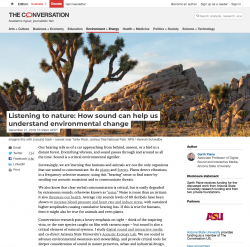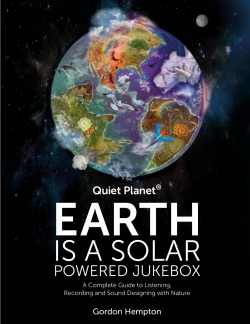Listening to nature: How sound can help us understand environmental change

Type
Journal
Authors
Paine ( Garth Paine )
Category
Publication Year
2018
URL
[ private ]
Tags
Abstract
Our hearing tells us of a car approaching from behind, unseen, or a bird in a distant forest. Everything vibrates, and sound passes through and around us all the time. Sound is a critical environmental signifier.
Increasingly, we are learning that humans and animals are not the only organisms that use sound to communicate. So do plants and forests. Plants detect vibrations in a frequency-selective manner, using this “hearing” sense to find water by sending out acoustic emissions and to communicate threats.
We also know that clear verbal communication is critical, but is easily degraded by extraneous sounds, otherwise known as “noise.” Noise is more than an irritant: It also threatens our health. Average city sounds levels of 60 decibels have been shown to increase blood pressure and heart rate and induce stress, with sustained higher amplitudes causing cumulative hearing loss. If this is true for humans, then it might also be true for animals and even plants.
Conservation research puts a heavy emphasis on sight – think of the inspiring vista, or the rare species caught on film with camera traps – but sound is also a critical element of natural systems. I study digital sound and interactive media and co-direct Arizona State University’s Acoustic Ecology Lab. We use sound to advance environmental awareness and stewardship, and provide critical tools for deeper consideration of sound in nature preserves, urban and industrial design...
Increasingly, we are learning that humans and animals are not the only organisms that use sound to communicate. So do plants and forests. Plants detect vibrations in a frequency-selective manner, using this “hearing” sense to find water by sending out acoustic emissions and to communicate threats.
We also know that clear verbal communication is critical, but is easily degraded by extraneous sounds, otherwise known as “noise.” Noise is more than an irritant: It also threatens our health. Average city sounds levels of 60 decibels have been shown to increase blood pressure and heart rate and induce stress, with sustained higher amplitudes causing cumulative hearing loss. If this is true for humans, then it might also be true for animals and even plants.
Conservation research puts a heavy emphasis on sight – think of the inspiring vista, or the rare species caught on film with camera traps – but sound is also a critical element of natural systems. I study digital sound and interactive media and co-direct Arizona State University’s Acoustic Ecology Lab. We use sound to advance environmental awareness and stewardship, and provide critical tools for deeper consideration of sound in nature preserves, urban and industrial design...
Description
https://theconversation.com/listening-to-nature-how-sound-can-help-us-understand-environmental-change-105794
Number of Copies
1
| Library | Accession No | Call No | Copy No | Edition | Location | Availability |
|---|---|---|---|---|---|---|
| Main | 339 | 1 | Yes |



